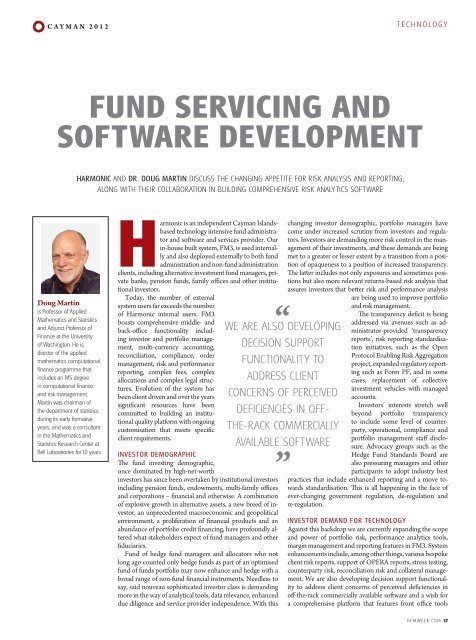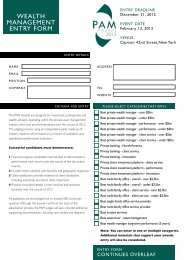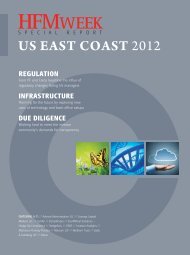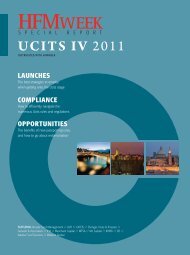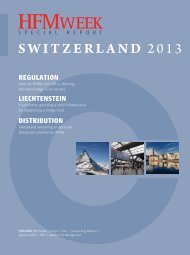CAYMAN 2012 - HFMWeek
CAYMAN 2012 - HFMWeek
CAYMAN 2012 - HFMWeek
- No tags were found...
Create successful ePaper yourself
Turn your PDF publications into a flip-book with our unique Google optimized e-Paper software.
<strong>CAYMAN</strong> <strong>2012</strong><br />
TECHNOLOGY<br />
FUND SERVICING AND<br />
SOFTWARE DEVELOPMENT<br />
HARMONIC AND DR. DOUG MARTIN DISCUSS THE CHANGING APPETITE FOR RISK ANALYSIS AND REPORTING,<br />
ALONG WITH THEIR COLLABORATION IN BUILDING COMPREHENSIVE RISK ANALYTICS SOFTWARE<br />
Doug Martin<br />
is Professor of Applied<br />
Mathematics and Statistics<br />
and Adjunct Professor of<br />
Finance at the University<br />
of Washington. He is<br />
director of the applied<br />
mathematics computational<br />
finance programme that<br />
includes an MS degree<br />
in computational finance<br />
and risk management.<br />
Martin was chairman of<br />
the department of statistics<br />
during its early formative<br />
years, and was a consultant<br />
in the Mathematics and<br />
Statistics Research Center at<br />
Bell Laboratories for 10 years.<br />
Harmonic is an independent Cayman Islandsbased<br />
technology intensive fund administrator<br />
and software and services provider. Our<br />
in-house built system, FM3, is used internally<br />
and also deployed externally to both fund<br />
administration and non-fund administration<br />
clients, including alternative investment fund managers, private<br />
banks, pension funds, family offices and other institutional<br />
investors.<br />
Today, the number of external<br />
system users far exceeds the number<br />
of Harmonic internal users. FM3<br />
boasts comprehensive middle- and<br />
back-office functionality including<br />
investor and portfolio management,<br />
multi-currency accounting,<br />
reconciliation, compliance, order<br />
management, risk and performance<br />
reporting, complex fees, complex<br />
allocations and complex legal structures.<br />
Evolution of the system has<br />
been client driven and over the years<br />
significant resources have been<br />
committed to building an institutional<br />
quality platform with ongoing<br />
customisation that meets specific<br />
client requirements.<br />
INVESTOR DEMOGRAPHIC<br />
The fund investing demographic,<br />
once dominated by high-net-worth<br />
investors has since been overtaken by institutional investors<br />
including pension funds, endowments, multi-family offices<br />
and corporations – financial and otherwise. A combination<br />
of explosive growth in alternative assets, a new breed of investor,<br />
an unprecedented macroeconomic and geopolitical<br />
environment, a proliferation of financial products and an<br />
abundance of portfolio credit financing, have profoundly altered<br />
what stakeholders expect of fund managers and other<br />
fiduciaries.<br />
Fund of hedge fund managers and allocators who not<br />
long ago counted only hedge funds as part of an optimised<br />
fund of funds portfolio may now enhance and hedge with a<br />
broad range of non-fund financial instruments. Needless to<br />
say, said nouveau sophisticated investor class is demanding<br />
more in the way of analytical tools, data relevance, enhanced<br />
due diligence and service provider independence. With this<br />
WE ARE ALSO DEVELOPING<br />
DECISION SUPPORT<br />
FUNCTIONALITY TO<br />
ADDRESS CLIENT<br />
CONCERNS OF PERCEIVED<br />
DEFICIENCIES IN OFF-<br />
THE-RACK COMMERCIALLY<br />
AVAILABLE SOFTWARE<br />
”<br />
changing investor demographic, portfolio managers have<br />
come under increased scrutiny from investors and regulators.<br />
Investors are demanding more risk control in the management<br />
of their investments, and these demands are being<br />
met to a greater or lesser extent by a transition from a position<br />
of opaqueness to a position of increased transparency.<br />
The latter includes not only exposures and sometimes positions<br />
but also more relevant returns-based risk analysis that<br />
assures investors that better risk and performance analysis<br />
are being used to improve portfolio<br />
and risk management.<br />
The transparency deficit is being<br />
addressed via avenues such as administrator-provided<br />
‘transparency<br />
reports’, risk reporting standardisation<br />
initiatives, such as the Open<br />
Protocol Enabling Risk Aggregation<br />
project, expanded regulatory reporting<br />
such as Form PF, and in some<br />
cases, replacement of collective<br />
investment vehicles with managed<br />
accounts.<br />
Investors’ interests stretch well<br />
beyond portfolio transparency<br />
to include some level of counterparty,<br />
operational, compliance and<br />
portfolio management staff disclosure.<br />
Advocacy groups such as the<br />
Hedge Fund Standards Board are<br />
also pressuring managers and other<br />
participants to adopt industry best<br />
practices that include enhanced reporting and a move towards<br />
standardisation. This is all happening in the face of<br />
ever-changing government regulation, de-regulation and<br />
re-regulation.<br />
INVESTOR DEMAND FOR TECHNOLOGY<br />
Against this backdrop we are currently expanding the scope<br />
and power of portfolio risk, performance analytics tools,<br />
margin management and reporting features in FM3. System<br />
enhancements include, among other things, various bespoke<br />
client risk reports, support of OPERA reports, stress testing,<br />
counterparty risk, reconciliation risk and collateral management.<br />
We are also developing decision support functionality<br />
to address client concerns of perceived deficiencies in<br />
off-the-rack commercially available software and a wish for<br />
a comprehensive platform that features front office tools<br />
HFMWEEK.COM 57


